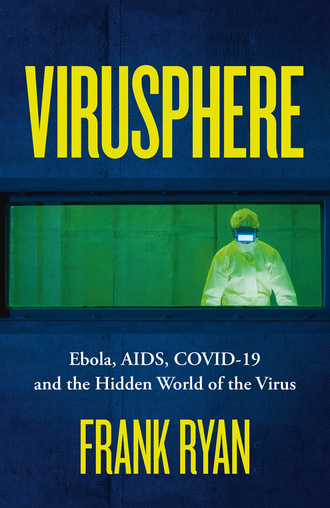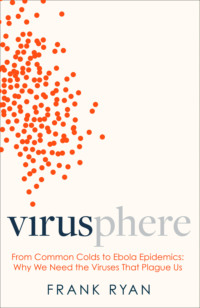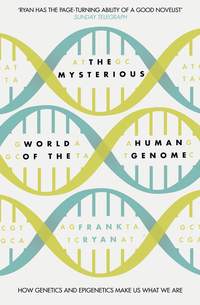
Полная версия
Virusphere
In this book we shall explore the truly strange, and intriguing, world of viruses. We might make a start by dispelling a common misconception; many people tend to confuse viruses with bacteria. This is perfectly understandable since viruses, like bacteria, cause many of the common ailments that afflict us in our ordinary lives, and particularly so the fevers that beset the lives of our children. Family doctors deal with these common ailments on a day-to-day basis, and they tend to treat them in similar ways, with antibiotics for bacterial illnesses and vaccination programmes or antiviral drugs aimed at protecting kids from the common viral infections. It is little wonder that people are apt to confuse viruses with bacteria. What then is the difference between the two?
In fact there are major differences between bacteria and viruses. The most obvious difference is one of scale: most viruses are much smaller than bacteria. We readily grasp this if we take a closer look at what is going on during those coughs and sneezes that we recognise as the harbingers of that bothersome cold. While a few other viruses can cause an illness resembling a cold, the majority of colds are caused by a particular virus, which goes by the name of ‘rhinovirus’. If one harks back to the sneezing, snuffling and nose-blowing that are the familiar symptoms of that developing cold, the name rhinovirus is apt, since ‘rhino’ derives from the Greek word, rhinos, for nose. Rhinoviruses are the commonest virus infections to afflict humans worldwide, with a seasonal peak in the autumn and early winter. The more we learn about the rhinovirus, the more we witness how well-suited it is to its natural environment, and to its life cycle of infectious behaviour and spread.
The rhinovirus is exceedingly tiny, at about 18 to 30 nanometres in diameter. A nanometre, or nm, is one-thousand-millionth of a metre. This clearly tells us that a single rhinovirus organism – it is referred to as a ‘virion’ – is absolutely minuscule. In the evolutionary system of classification known as ‘taxonomy’, rhinoviruses are classed as a genus within the family of the ‘picornaviruses’, a word derived from pico for small, and rna, because the rhinovirus genome is made up of the nucleic acid RNA rather than the more familiar DNA. Let us put aside any discussion of these genetic molecules for the moment, but we shall return to consider some remarkable implications of RNA-based viral genomes in subsequent chapters.
Returning to the differences in scale between viruses and bacteria, rhinoviruses are far too small to be seen under the ordinary laboratory light microscope. The virions can only be visualised under the phenomenal magnification of the electron microscope, when they appear to be roughly spherical in shape, resembling tiny balls of wool. In fact, if we examine the individual virions more closely under the electron microscope, we see that they are not really spheres but have multifaceted surfaces, rather like cut diamonds. In the technical jargon, the multifaceted surface of the rhinovirus is the viral ‘capsid’, which is the viral equivalent of a human cell’s enclosing membrane. This capsid has a striking mathematical symmetry comprising 20 equilateral triangles. All viruses have genomes, made up of either DNA or its sister molecule, RNA. The protein capsid acts as a protective shell that encloses the viral genome. It is the capsid that gives rhinoviruses their quasi-crystalline appearance, known as ‘icosahedral’ symmetry – the term is simply the Greek for ‘twenty-sided’. The multifaceted symmetry is not comprised of diamantine crystal, however, but constructed by a biochemical protein assembly.
Microbiologists had long recognised the presence of viruses before the electron microscope was invented. They found ways of detecting the presence of viruses from their effects on host cells, and they could even count their precise numbers from their cytopathic effects in cultures. It will come as no surprise to discover that the best cultures for growing rhinoviruses are cells derived from the human nasal lining, or the lining of the windpipe, or trachea. We are equally unsurprised to learn that the best temperature at which to culture cold viruses is between 33°C and 35°C, which is the temperature found within our human nostrils on a cold autumnal or winter’s day.
Rhinoviruses are highly adapted for survival in their host environment. They are also highly adapted to infect a specific host. This became apparent when scientists attempted to infect laboratory animals, including chimpanzees and gibbons, with a variety of different subtypes of rhinovirus that readily infected humans. They could not replicate the symptoms of a typical cold in any of the animals. From this we glean an important lesson about viruses: the rhinovirus is most particular when it comes to its choice of host, which is exclusively Homo sapiens. This has a pertinent significance; it means that human infection is vitally important to virus survival. Only through human to human contagion can the virus be passed on and breed new generations of rhinovirus. We are the natural reservoir of the cold virus.
But a moment or two of reflection on such exclusivity provokes a tangential thought – and a pertinent question. These minuscule polyhedral balls have no obvious means of locomotion. How can they possibly move about through our human population to effortlessly spread their infection across national and even international boundaries?
In fact, we already have the answer: it is implied in the very title of this chapter. Why do we cough and sneeze? We do so because this is what happens when our noses, throats and windpipe passages feel irritated. It is part of the natural defences against foreign material entering passages where it could block our airways and, implicitly, obstruct them and threaten our breathing. What rhinoviruses do is to provoke the same physiological responses by irritating the linings of our nasal passages. The viruses spread from person to person because they are explosively ejected into the ambient air with every cough and sneeze, to be inhaled and subsequently infect new hosts. And here, once again, we learn something vitally important about viruses. The viruses do not need any mechanism of locomotion because they hitch a ride on our own locomotion, and everywhere we go, we further oblige them by spreading their contagion by coughing and sneezing.
How clever, we are inclined to think, are viruses!
But viruses could not possibly be clever. They are far too simple to be capable of thinking for themselves. We are instead confronted by another of the numerous enigmas in relation to viruses. How, for example, could an organism some paltry 30 nanometres in diameter acquire such devious but also such highly effective patterns of behaviour as we discover in the common cold? The answer is that viruses do this through their evolution. Indeed, viruses have an extraordinary capacity to evolve. They evolve much faster than humans, even much faster than bacteria. Over subsequent chapters we shall see how that viral employment of host locomotion is one of many such evolutionary adaptations.
What then do rhinoviruses do when they get inside us?
We have seen that the rhinovirus has a specific target cell, the cilia-flapping cells lining the nasal passages. Once inhaled, the virus targets these lining cells, discovering a specific ‘receptor’ in the cell’s surface membrane, after which the virus uses the receptor to break through the membranous barrier and gain entry into the cell’s interior, or cytoplasm. Here the virus hijacks the cell’s metabolic pathways to convert it into a factory for the replication of daughter viruses. The daughter viruses are extruded into the nasal and air passages, there to search out new cells to infect and continue the invasive process. It seems to require only a tiny dose of virus to be inhaled from the expelled cough or sneeze of an infected person to initiate infection in a new individual. After arrival, the incubation period from virus entry to infected nasal cells exuding new daughter viruses can be as little as a day. We don’t have much of a chance of escaping infection once the virus has been inhaled. Virus replication peaks by day four.
Fortunately, it isn’t all one way. Even as the virus is launching its attack, the human immune system has registered the threat, and it has recognised the viral antigenic signature – what we call the serotype. The problem is that the arrival of a new serotype requires time for the immune system to recognise the threat and to build up a formidable arsenal of responses. By day six the nasal passages are the focus of a virus versus immunological war zone, with no quarter asked or given on either side. This intense immune response causes the nasal passages to shed most of their lining cells, exposing highly inflamed raw surfaces, with narrowed breathing passages exuding copious mucus, which contains rising levels of antibodies to the virus. The rhinovirus is eventually killed off by the neutralising antibodies and the ‘war detritus’ is cleared away by the gobbling action of phagocytic white cells. During this immunological conflagration the new host follows the same unfortunate cycle of being infectious to others, through coughing and sneezing, for a period of anything from one to three weeks.
There is an adage that colds will not kill you. This is largely true, but colds can make children more liable to sinusitis and otitis media, a nasty bacterial infection of the middle ear. Colds can also precipitate asthma in people constitutionally prone to it, and they can provoke secondary bacterial chest infections in people suffering from cystic fibrosis or chronic bronchitis. Nevertheless, the salutary consolation is that, in the great majority of human infections, the rhinovirus eventually passes on by and we make a complete recovery.
Is there anything we can do to minimise the risk of contracting that cold – or is there any effective treatment when we are afflicted?
In Roman times, Pliny the Younger recommended kissing the hairy muzzle of a mouse as a remedy for colds. Benjamin Franklin was more sensible, suggesting that exposure to cold and damp in the atmosphere was responsible for the development of a cold. He also recommended fresh air and avoiding the exhaled air of other people. More modern times have seen a veritable cornucopia of quack remedies for prevention or treatment of colds. One of the most popular was vitamin C, championed by the distinguished American chemist, Linus Pauling. But alas, when subjected to scientific scrutiny it proved no more effective than the mouse’s whiskers. Perhaps we should focus more on common sense? Colds are contracted from the coughs and sneezes of infected people. People in congested offices, or even relatives who find themselves ill at home, should follow the old adage: trap your germs in a handkerchief. If an individual is deemed to be at a particularly high risk from a cold, wearing a virus-level face mask would certainly reduce the likelihood of infection when exposed to an infectious source.
A pertinent question remains: why, then, if our immune system has come to recognise and react to the rhinovirus, are we still susceptible to further colds during our lifetime? In fact, there are roughly 100 different ‘serotypes’ of the rhinovirus, so immunisation to any one type would not provide adequate protection from the others. Added to this is the fact that serotypes are capable of evolving so that their antigenic properties are apt to change.
3
A Plague Upon a Plague
In 1994 the East African nation of Rwanda erupted onto the world’s news and television screens when a simmering civil war between the major population of Hutus and minority population of Tutsis erupted into a genocidal slaughter of the minority population. But despite the deaths of half a million Tutsis, the Hutu perpetrators lost the war, causing more than two million of them to flee the country. Roughly half of these fled northwest, across the border of what was then Zaire, these days the Democratic Republic of the Congo, where they ended up around the town of Goma. Up to this point Goma had been a quiet town of some 80,000 people, nestling by Lake Kivu in the lee of a volcano. Goma now found itself overwhelmed by a desperate torrent of refugees, carrying everything from blankets to their meagre rations of yams and beans. Two hundred thousand arrived in a single day, confused, thirsty, hungry and homeless. They camped on doorsteps, in schoolyards and cemeteries, in fields so crowded that people slept standing up. Agencies from the world’s media flocked to the vicinity, reporting the chaos and the urgent need for shelter, food and water.
A reporter for Time magazine estimated that the volume of refugees needed an extra million gallons of purified water each day to prevent deaths from simple thirst, meanwhile the rescue services were managing no more than 50,000. Desperate people foraged for fresh water, scrabbling hopelessly in a hard volcanic soil that needed heavy mechanical diggers to sink a well or a latrine. Human waste from the relief camps fouled the waters of the neighbouring Lake Kivu, creating the perfect circumstances for the age-old plague of cholera to emerge. Within 24 hours of confirmation of the disease some 800 people were dead. Then it became impossible to keep count.
Viruses are not the only cause of plagues, which include a number of lethal bacteria, such as the beta-haemolytic streptococcus, tuberculosis and typhus, as well as some protists, which cause endemic illnesses such as malaria, schistosomiasis and toxoplasmosis. Cholera is a bacterial disease, caused by the comma-shaped Vibrio cholerae. The disease is thought to have originated in the Bengal Basin, with historical references to its lethal outbreaks in India from as early as 400 CE. Transmission of the germ is complex, involving two very different stages. In the aquatic reservoir the bug appears to reproduce in plankton, eggs, amoebae and debris, contaminating the surrounding water. From here it is spread to humans who drink the contaminated water, where it provokes intense gastroenteritis, which proves rapidly fatal from massive dehydration as a result of the fulminant ‘rice-water’ diarrhoea. This human phase offers a second reservoir for infection to the bug. If not prevented by strict hygiene measures, the extremely contagious and virulent gut infection causes massive effluent of rice-water stools that are uncontrollable in the individual sufferer, so that they contaminate their surroundings, and especially any local sources of drinking water, leading to a vicious spiral of very rapid spread and multiplication of the germ.
During the nineteenth century, cholera spread from its natural heartland, provoking epidemics in many countries of Asia, Europe, Africa and America. The massive diarrhoeal effluent of cholera is unlike any normal food poisoning. An affected adult can lose 30 litres of fluid and electrolytes in a single day. Within the space of hours, the victims go into a lethargic shock and die from heart failure.
The English anaesthetist, John Snow, was the first to link cholera with contaminated water, expounding his theory in an essay published in 1849. He put this theory to the test during a London-based outbreak around Broad Street, in 1854, when he predicted that the disease was disseminated by the emptying of sewers into the drinking water of the community. Snow’s thoughtful research led to the civic authorities throughout the world realising the importance of clean drinking water. Today the life of an infected person can be saved by very rapid intravenous replacement of fluid and electrolytes, but the size of the outbreak around Lake Kivu, and the relative paucity of local medical amenities, limited the clinical response. The situation was made even worse by the recognition that the cholera in the Rwandan refugee camps was now confirmed as the 01-El Tor pandemic strain of Vibrio, known to be resistant to many of the standard antibiotics. This presented immense problems for the medical staff from local health ministries and those arriving from the World Health Organization. Even though the response was one of the largest relief efforts in history – involving the Zairian armed forces, every major global relief agency and French and American army units – the spread of cholera was too rapid for their combined forces to take effect.
Three weeks after the outbreak began, cholera had infected a million people. Even with the modern knowledge and the desperate efforts of civic and medical assistance, the disease is believed to have killed some 50,000. It is hard to believe that so resistant a plague bacterium as the Vibrio cholerae might itself be prey to another microbe. But exactly such an attack, of a mystery microbe upon the cholera vibrio, had been recorded in a historic observation by another English doctor close to the very endemic heartland of the disease, a century before the outbreak at Lake Kivu.
In 1896 Ernest Hanbury Hankin was studying cholera in India when he observed something unusual in the contaminated waters of the Ganges and Yamuna Rivers. Hankin had already discovered that he could protect the local population from the lethal ravages of the disease by the simple expedient of boiling their drinking water before consumption. When, in a new experiment, he added unboiled water from the rivers to cultures of the cholera germs and observed what happened, he was astonished to discover that some agent in the unboiled waters proved lethal to the germs. It was the first inkling that some unknown entity in the river waters appeared to be preying upon the cholera bacteria.
Hankin probed the riddle further. He found that if he boiled the water before adding it to the cholera germ cultures this removed the bug-killing effect. This suggested that the agent that was killing the cholera germs was likely to be of a biological nature. He needed to know if it was another germ – sometimes germs antagonised one another – or if it was something completely different, a truly mysterious agent, that was killing the germs. Hankin decided that he would set up a new experiment using a device known as a Chamberland-Pasteur ‘germ-proof’ filter, which had been developed 12 years earlier by the French microbiologists Charles Chamberland and Louis Pasteur. The Chamberland-Pasteur filter was a flask-like apparatus made out of porcelain that allowed microbiologists to pass fluid extracts through a grid of pores varying from 0.1 to 1.0 microns in diameter – from 100-billionths to 1,000-billionths of a metre – that were designed to trap bacteria but allow anything smaller to pass through. Two years after the filter’s invention, a German microbiologist, Adolf Mayer, showed that a common disease of tobacco plants, known as tobacco mosaic disease, could be transmitted by a filtrate that had passed through the finest Chamberland-Pasteur filter. Unfortunately, he persuaded himself that the cause of the disease must somehow be a very tiny bacterium. In 1892 a Russian microbiologist, Dmitri Ivanovsky, repeated the experiment to get the same results. He refuted a bacterial cause, but still arrived at the mistaken conclusion that there must be a non-biological chemical toxin in the liquid extract. Finally, in 1896, the same year that Hankin was looking for his mystery agent in the Indian river waters, a Dutch microbiologist, Martinus Beijerinck, repeated the filter experiment with tobacco mosaic disease; but Beijerinck concluded that the causative agent was neither a bacterium nor a chemical toxin but rather ‘a contagious living fluid’. Although Beijerinck was closest of all to the truth, he was once again wrong. Today we know that the cause of tobacco mosaic disease is a virus – the tobacco mosaic virus. But thanks to Beijerinck’s mistaken finding of a ‘contagious fluid’, the current Oxford English Dictionary definition of a ‘virus’ has it as: ‘a poison, a slimy fluid, an offensive odour, or taste’.
Viruses are not poisons, or slimy fluids, or offensive odours or tastes, but rather organisms – truly remarkable organisms – that are different from bacteria, indeed utterly different from any other organisms on Earth. The great majority of viruses are very small, tiny enough to pass through Chamberland-Pasteur filters.
Of course, Hankin knew nothing of the existence of viruses when he passed the river water through the refined sieve of a Chamberland-Pasteur filter. Although he was in no position to offer a likely explanation or name for the mystery agent, he had discovered one of the most important and ubiquitous of viruses on Earth: a member of the group known today as ‘bacteriophage’ viruses, so-named from the Greek phagein, which means to devour. That is exactly what was happening to the cholera germs in Hankin’s experiments: they were being ‘devoured’ by bacteriophage viruses.
The true nature of Hankin’s discovery remained a mystery until 1915, when English bacteriologist Frederick Twort discovered a similarly minuscule agent that could pass through the Chamberland-Pasteur filters and yet remained capable of killing bacteria. By now viruses were known to exist even though biologists knew very little about them. Twort surmised that he was observing either a natural phase of the life cycle of the bacteria, the result of a fatal enzyme produced by the bacteria themselves, or a virus that grew on and destroyed the bacteria. Some two years later, a pioneering, self-taught, French-Canadian microbiologist, Félix d’Herelle, finally solved the mystery.
D’Herelle was born in the Canadian city of Montreal but considered himself a citizen of the world. Before becoming involved with viruses, he had already travelled widely, working in numerous American, Asian and African countries, to finally settle at the Pasteur Institute in Paris. At this time the discipline of microbiology was a fashionable scientific research endeavour and it was rapidly expanding its knowledge base. During his researches in Tunisia, d’Herelle had come across what was probably a virus infecting a bacterium that itself caused a lethal plague in locusts. Now working at the famous Institute, even as the First World War raged nearby, he took a particular interest in the grimy disease known as bacterial dysentery, which was killing soldiers in their muddy trenches.
Bacterial – as opposed to amoebic – dysentery is caused by a genus called Shigella, which is passed on from the infected individuals through faecal hand-to-mouth contagion. The resultant illness ranges from a mild gut upset to a severe form, with agonising griping spasms of the bowel accompanied by high fever, bloody diarrhoea and what doctors call ‘prostration’. In July and August 1915 there was an outbreak of haemorrhagic bacterial dysentery among a cavalry squadron of the French army, which was stalemated on the Franco-German front little more than 50 miles from Paris. The urgent microbiological investigation of the outbreak was assigned to d’Herelle. In the course of intensive investigation of the bugs responsible, he discovered ‘an invisible, antagonistic microbe of the dysentery bacillus’ that caused clear holes of dissolution in the otherwise opaquely uniform growth of dysentery bacteria on agar culture plates. Unlike his earlier colleagues, he had no hesitation in recognising the nature of what he had found. ‘In a flash I understood: what caused my clear spots was … a virus parasitic on the bacteria.’
D’Herelle’s hunch proved to be correct. Indeed, it would be d’Herelle who would give the virus the name we know it by today: he called it a ‘bacteriophage’. Then the French-Canadian microbiologist had an additional stroke of luck. When studying an unfortunate cavalryman suffering from severe dysentery, he performed repeated cultivations of a few drops of the patient’s bloody stools. As usual, he grew the dysentery bug on culture plates and passed a fluid extract through a Chamberland-Pasteur filter, thus obtaining a filtrate that could be tested for the presence of virus. Day after day, he tested the filtrate by adding it to fresh broth cultures of the dysentery bug in glass bottle containers. For three days the broth quickly turned turbid, confirming teeming growth of the dysentery bug. On the fourth day new broth cultures initially became turbid as usual, but when he incubated the same cultures for a second night he witnessed a dramatic change. In his words, ‘All the bacteria had vanished: they had dissolved away like sugar in water.’





